France laid its first submarine cable across the Atlantic in 1869, from the cove of Petit Minou (about 10km west of Brest on the French mainland) to
Saint-Pierre et Miquelon (off the coast of Newfoundland, Canada), with an extension to
Duxbury, Massachusetts. The cable was made and largely financed in Britain, and after some early rate competition the French company was taken over by the Anglo-American Telegraph Company in 1873.
There was a certain amount of politics and underhanded business dealings in arranging the landing of the cable in the United States against the monopoly of the Anglo-American company, which James Scrymser describes in his 1915 autobiography.
Duxbury was incorporated in 1637. Situated 33 miles
south of Boston and 246 miles from New York City, the town is set at the
head of Plymouth Bay “in a lovely undulating landscape washed by
a beautiful sheet of water”[1]
A center of shipbuilding until the mid-nineteenth
century, when ships became too large for the shallow bay, Duxbury achieved
a measure of fame as the landing site for the third Atlantic Cable. This
1869 French cable was the beginning of the second period of long-distance
submarine cable laying, when the art had advanced beyond the experimental
and satisfactory results were likely. A contemporary review of the
decade of the 1860s illustrates this[2]:
| The
failure to lay down an Atlantic telegraph in the last previous decade
(1858) had indisposed men to undertakings so vast in every sense,
and so doubtful in every way. Some years passed before the attempt
was renewed, but the genius and energy of our countryman, Mr. Cyrus
W. Field, finally cleared all difficulties away, after repeated failures;
and in 1866 the Atlantic Telegraph became an accomplished fact, just
in time to furnish the news of the closing events of the Germano-Italian
war. A cable that had previously been lost was recovered, and two
lines thus existed between Europe and America.
In
1869 the French cable was laid, connecting Brest with Duxbury (Massachusetts).
The great problem had been solved in 1866, and for more than four
years daily communication between the Old World and the New has
taken place. The telegraph has been extended to India, and there
is now communication through its existence between San Francisco
and Calcutta.
These
great enterprises all belong to the seventh decade of the century;
and others are in progress which will bring India in connection
with Australia, and the extremities of Eastern Asia with those of
Western America.
|
Julius Reuter, of the famous news agency,
and Baron Emil d’Erlanger, backed by British financiers, were the promoters of La Société du Câble
Transatlantique Française.
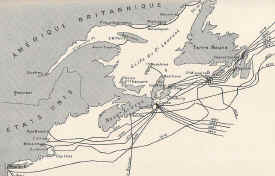 |
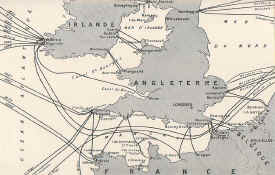 |
| These cable
maps, published by the International Telegraph Bureau, Bern, in 1897,
show the 1869 cable route from Brest to St. Pierre & Miquelon,
continuing to Sydney and Duxbury. The maps also show eleven
further transatlantic cables laid between 1869 and 1897, evidence
of the rapid development of the cable network in the three decades
following the laying of the French cable[3]. |
The contract to manufacture
and lay the cable was given to Telcon, the Telegraph Construction and Maintenance
Company, of London. Telcon manufactured the Brest to St. Pierre section
of the cable, and subcontracted W.T. Henley to make the St. Pierre to
Sydney length.
|
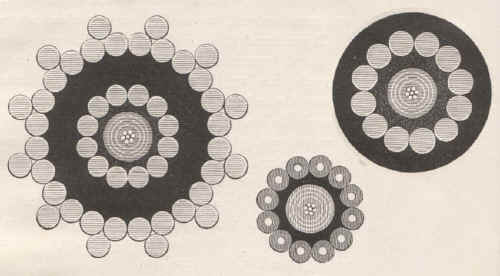
The illustration shows the three weights
of cable used for the main run of 2584nm from Brest to St. Pierre. All had an identical core of 7 copper strands. On the left is the shore-end cable, armoured with 12 No. 7 BWG and 12 strands of 3 No. 4½ to resist damage from rocks and ships’ anchors. On the right is the intermediate cable, 12 No. 4 BWG, used to run from the shallows near shore out to deeper water. In the center is the deep-sea cable, the main length of the run, which has the lightest armouring of 12 No. 13 BWG each wrapped in 5 strands tanned manilla.
The diagrams are to scale; the
deep-sea cable is about 1" diameter and is similar to that used on the 1866 Atlantic cable, but with twelve armouring wires rather than the ten of the 1866 cable.
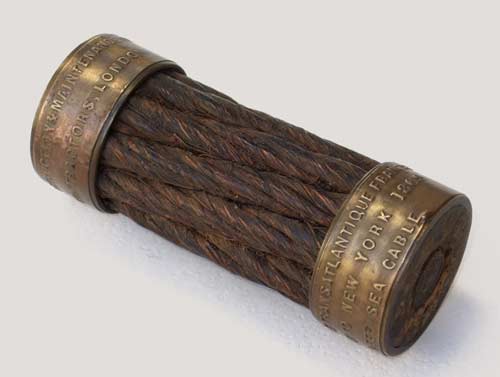
Deep sea cable mounted sample.
The engraved mounts at each end of the cable are shown below. |

Telegraph Construction & Maintenance Compy Limited
Contractors, London
Société du Câble
Transatlantique Française Limited
Brest to New York 1869
Deep Sea Cable
|
Oddly, the cable route of this section is is given as “Brest to New York”, and this section has ten armouring wires rather than the twelve shown in the diagram above.
This section is identical to a recovered piece of this cable in the Science Museum (London) Making of the Modern World gallery, where it is described as “...laid by the Great Eastern in 1869.” An end view of the Science Museum cable showing the ten armouring wires may be seen on the Recovered Cables page. |
| The 749nm run from Saint Pierre to Duxbury also used a 7-strand copper conductor, but was made by W.T. Henley Telegraph Works Company and had different armouring from the transatlantic cable. The main cable had 10 No. 8 BWG, intermediate 12 No. 4 BWG, shore ends 10 No. 8 BWG plus 12 strands 3 No. 4½ BWG. |
 |
St Pierre to Duxbury main cable
Images courtesy of the Ladd Observatory collection at Brown University.
Photographer Dave Fischer. |
The main cable was laid by Great Eastern with CS Chiltern and CS Scanderia. CS Hawk laid the European shore end
and CS William
Cory laid and landed the Sydney and Duxbury extensions[4].
|

1885 map of Duxbury showing the cable
station
and the cable laid across the marsh
|
The Great Eastern had bankrupted
a series of owners, but had successfully laid the 1866 cable from Ireland
to Newfoundland. After this, though, the ship languished for lack of work.
This article appeared in Scientific American in April 1868[5]:
| An
“Elephant” Indeed
The owners
of the Great Eastern, mourning not simply a non-appearance of dividends,
but a very heavy expense in keeping the big ship in existence, are
in a sad state of perplexity, not knowing what is to become of their
unproductive property. At the late annual meeting of the shareholders,
the directors’ report deplored the failure of the company to complete
its contract with the new French cable company, the latter refusing
to act up to the terms of the agreement, and the whole affair is
now before the law courts for adjudication. As far as the future
was concerned, the chairman tried to persuade the company that the
prospects were encouraging as there were other cables to be laid
and he was certain that their ship was the only one which could
accomplish such an undertaking successfully. One hopeful proprietor
suggested that the Leviathan should he converted into an immense
floating hotel, but the plan was promptly voted down. The shareholders
are certainly deserving of public sympathy.
|
The difficulty with the French cable company was apparently resolved,
as just over a year later, on 17 July 1869, Scientific American
reported[6]:
| The
work of constructing the telegraph line from Boston to Duxbury, Mass.,
to connect with the new French cable, was begun on the 19th of June. |
British engineer Fleeming Jenkin noted in his memoirs[7]:
| JUNE
17, 1869. - Here are the names of our staff in whom I expect you to
be interested, as future GREAT EASTERN stories may be full of them:
Theophilus Smith, a man of Latimer Clark’s; Leslie C. Hill, my prizeman
at University College; Lord Sackville Cecil; King, one of the Thomsonian
Kings; Laws, goes for Willoughby Smith, who will also be on board;
Varley, Clark, and Sir James Anderson make up the sum of all you know
anything of. A Captain Halpin commands the big ship. There are four
smaller vessels. The WM. CORY, which laid the Norderney cable, has
already gone to St. Pierre to lay the shore ends. The HAWK and CHILTERN
have gone to Brest to lay shore ends. The HAWK and SCANDERIA go with
us across the Atlantic and we shall at St. Pierre be transhipped into
one or the other.
JUNE 18. SOMEWHERE
IN LONDON. - The shore end is laid, as you may have seen, and we
are all under pressing orders to march, so we start from London
to-night at 5.10.
June 20. OFF
USHANT. - I am getting quite fond of the big ship. Yesterday morning
in the quiet sunlight, she turned so slowly and lazily in the great
harbour at Portland, and bye and bye slipped out past the long pier
with so little stir, that I could hardly believe we were really
off. No men drunk, no women crying, no singing or swearing, no confusion
or bustle on deck - nobody apparently aware that they had anything
to do. The look of the thing was that the ship had been spoken to
civilly and had kindly undertaken to do everything that was necessary
without any further interference. I have a nice cabin with plenty
of room for my legs in my berth and have slept two nights like a
top. Then we have the ladies’ cabin set apart as an engineer’s office,
and I think this decidedly the nicest place in the ship: 35 ft.
x 20 ft. broad - four tables, three great mirrors, plenty of air
and no heat from the funnels which spoil the great dining-room.
I saw a whole library of books on the walls when here last, and
this made me less anxious to provide light literature; but alas,
to-day I find that they are every one bibles or prayer-books. Now
one cannot read many hundred bibles. . . . As for the motion of
the ship it is not very much, but ’twill suffice. Thomson shook
hands and wished me well. I DO like Thomson. . . . Tell Austin that
the GREAT EASTERN has six masts and four funnels. When I get back
I will make a little model of her for all the chicks and pay out
cotton reels. . .
Here we are
at 4.20 at Brest. We leave probably to-morrow morning.
JULY 12. GREAT
EASTERN. - Here as I write we run our last course for the buoy at
the St. Pierre shore end. It blows and lightens, and our good ship
rolls, and buoys are hard to find; but we must soon now finish our
work, and then this letter will start for home. . . . Yesterday
we were mournfully groping our way through the wet grey fog, not
at all sure where we were, with one consort lost and the other faintly
answering the roar of our great whistle through the mist. As to
the ship which was to meet us, and pioneer us up the deep channel,
we did not know if we should come within twenty miles of her; when
suddenly up went the fog, out came the sun, and there, straight
ahead, was the WM. CORY, our pioneer, and a little dancing boat,
the GULNARE, sending signals of welcome with many-coloured flags.
Since then we have been steaming in a grand procession; but now
at 2 A.M. the fog has fallen, and the great roaring whistle calls
up the distant answering notes all around us. Shall we, or shall
we not find the buoy?
JULY 13. -
All yesterday we lay in the damp dripping fog, with whistles all
round and guns firing so that we might not bump up against one another.
This little delay has let us get our reports into tolerable order.
We are now at 7 o’clock getting the cable end again, with the main
cable buoy close to us.’
A TELEGRAM
OF JULY 20: I have received your four welcome letters. The Americans
are charming people. |
|
|
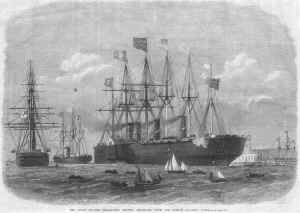
The Great Eastern Steam-Ship Leaving
Sheerness
With The French Atlantic Cable.
The Illustrated London News, June 26, 1869 |
Willoughby Smith, in his book “The
Rise and Extension of Submarine Telegraphy”[8] gives a detailed account of the cable laying by Great Eastern,
the voyage beginning off the coast of France on 21 June 1869. The
ship was captained by Robert Halpin, and on board was an assemblage
of many famous cable men, including Sir James Anderson (captain of
the Great Eastern on its previous Atlantic Cable voyages),
Sir Daniel Gooch, Willoughby Smith, Latimer Clark, Fleeming Jenkin,
and C.F. Varley, among others. William Thomson (Lord Kelvin) was at
the cable station in Brest making measurements between ship and shore
as the cable was laid.
The cable was landed at St. Pierre, off the coast of
Newfoundland, on 13 July 1869. This was the end of Great Eastern’s
involvement in this cable, but not the end of the cable. From St. Pierre
two cables were run: one to Sydney, Nova Scotia, the other to Duxbury.
Smith was unwell, and went back to England on Great
Eastern, but he reports the landing of the cable in Duxbury. The
ships involved in this last part of the expedition were the Chiltern,
Scanderia, and William
Cory:
| Friday,
July 23rd. The deep sea portion of the cable was completed off Cape
Cod at 11.20 a.m. The splice was then made between deep sea and intermediate
portions, and at 12.45 we commenced paying out again.
After paying
out the thirty-one knots of intermediate cable we commenced on the
heavy shore end (4.45 p.m.), and at 6.30 we had arrived at our anchorage
opposite the landing place. The hands at once commenced to coil
the end into a boat, and in about three hours the end was conducted
into the cable house on shore.
|
Photographer Martin Chandler recorded the cable landing in a set
of stereoviews, some of which are illustrated in this article. Chandler’s
business location is listed on the back of the cards as Marshfield, Massachusetts,
immediately to the north of Duxbury.
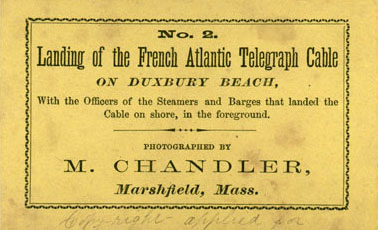
Listed initially as a daguerreian, Chandler later
took stereo views, and remained in business in Marshfield until 1896.
According to information received in May
2003 from Harry Chandler (Martin’s brother’s great-great-grandson), Martin
Chandler died in Marshfeld in 1897. The Marshfield Historical Commission
has many of Chandler’s photographs (including one of his wagon and photographic
equipment) and reprints of his photographs hang in the Marshfield Town
Hall.
On 7 August 1869, Scientific American reported
the successful completion of the cable[9]:
| The
French Cable Laid
The French
Atlantic Cable has been successfully laid, making in all, three
cables which have been stretched between the Eastern and Western
hemispheres. The Great Eastern has proved herself especially useful
in the laying of long cables, and should she now be laid up forever,
her history will always be connected with that of the most remarkable
enterprises ever undertaken and completed. The efficiency of submarine
cables, and their immunity from interruption through the effect
of atmospheric electricity suggests the expediency of connecting
all large sea ports by cables instead of land lines.
|
On that same date the Société du Câble
Transatlantique Française placed a classified advertisement in The Times with their tariff:
| SOCIÉTÉ du CÂBLE TRANSATLANTIQUE FRANÇAISE (Limited).—French Atlantic Telegraph Company.
Notice.—The CABLE of the above Company will be OPENED to the public for Messages between Europe and America on and after Sunday, the 15th August.
Until further notice the tariff to be charged on a message between Great Britain or France and New York or Boston will be £1 12s. (40 francs) for 10 words and 3s. 3d. (4 francs) for each additional word.
Messages will be received at the office of the Submarine Telegraph Company, 58, Threadneedle-street, and at all London and provincial offices of the United Kingdom Telegraph Company (Limited).
N.B. Press messages will be taken at half the above rate.
ROBERT SLATER, Secretary
Bartholomew-house, London, August 2, 1869. |
Right underneath the French company’s ad was this one, showing the immediate effect on the British market of the opening of the French cable:
ANGLO-AMERICAN TELEGRAPH COMPANY (Limited).
Messages to America—Further REDUCTION OF TARIFF from the United Kingdom to New York, to commence August 10th, 1869. 30s. for 10 words and 3s. for each extra word.
Press messages will be transmitted at half the above rates.
Messages will be received at all the Stations of the Electric and International Telegraph Company and the British and Irish Magnetic Telegraph Company.
JOHN C. DEANE, Secretary
No. 25, Old Broad-street, London, Aug. 5, 1869. |
The French company was absorbed by Anglo-American in 1873.
The next month, on 25 September 1869, Scientific American printed
a report, extracted from the Boston Advertiser, of the visit
of members of the Scientific Association to the cable station at Duxbury,
which gives an interesting insight into the workings of the cable[10]:
| Mode
of Working the French Cable
A few of the
members of the Scientific Association, which closed its session
at Salem last week, have been making a visit to Duxbury, the terminus
of the newly laid French Cable. What they saw is pleasantly told
by the Boston Advertiser, from which we make the following extracts:
In an old but
well preserved clapboard mansion of that quaint old town were found
the headquarters of this new and wonderful highway. The visitors
were cordially welcomed by the manager, Mr. Brown, and were at once
brought into the presence of the flitting, flame-like image which
indicated, in symbols, on a graduated screen, the thoughts working
at that instant on the other side of the Atlantic. Interpreting
the fitful tremor of the image, or line of light, one inch in length,
and one eighth of an inch in breadth, the youthful interpreter,
who did not look the wizard that he was, calmly read, for transcription
by his assistant, a message in which occurred, at intervals, the
words ‘New Orleans’ - ‘Citizens’ - etc., etc. While inspecting the
apparatus the members of the party received the following message
fresh from France, sent expressly to them:
“To Duxbury,
from Brest - Time 5:20 P.M [Paris Time]
“The company present their compliments to the gentlemen assembled
at Boston, and hope to be able to send them news of the great international
boat race that will be gratifying to both nations.”
The usual rate
of transmission is about ten or twelve words per minute. Looking
for the mechanism by which these wonderful results were obtained,
the inquiring visitors observed, on their right, placed on a marble
pedestal, a medium-sized spool of silk-covered copper wire, said
to consist of several thousand turns or convolutions, in the center
of which spool, suspended by a single silkworm fiber, was a minute
mirror attached to a little magnet made from a piece of watch spring.
From a lamp, properly placed and shaded, a beam of light was thrown
upon this mirror, and from the mirror was reflected, two hundred
times enlarged, upon the graduated screen in front of the interpreter,
the flame-like image already mentioned. In transmitting, from Duxbury
to Brest, the operator, with his right hand, makes use of two keys
or springs, one of which, being pressed, causes, at Brest, a deflection
in a similar mirror, sending the image-flame to the right, while
pressing the other key deflects the mirror at Brest in the opposite
direction, sending the image to the left Its indications are thus
interpreted; a jerk or flitting once to the left and then once to
the right denotes the letter a; a flitting once to the right and
then three times to the left, denotes the letter b; and thus, letter
by letter, the words are spelled
Passing into
an adjoining room the delicate instruments used for testing the
electric conduction of the cable are shown among which are condensers
and batteries, rheostats and shunts, bridges, switches, and plugs,
and, crowning all, the wonderful astatic galvanometer of Sir William
Thompson. But possibly it would weary our readers to tell of ohms
and megohms, farads and megafarads, volts and microvolts, and all
the terminology of conduction, resistance, electrostatic capacity,
and continued electrification. It may, however, gratify them to
learn that the insulation of the deep-sea cable, between Brest and
St. Pierre, has more than doubled in efficacy during the short month
which has elapsed since this cable was first committed to the embraces
of Old Ocean - as is evinced by the fact that, soon after it was
laid, the insulation resistance rose to 2300 megohms, and has since
been gradually increasing until it is now 5000 megohms per nautical
mile. This improvement in the insulation of the deep-sea cable is
believed to be mainly due to the coldness or diminished temperature
to which it is subjected at great ocean depths. The insulation resistance
of the portion of the cable connecting Duxbury and St. Pierre is
much less, namely, 1500 megohms per nautical mile.
If one would
inquire of a cable electrician - what is a megohm? he might, with
propriety, be told that it is a million ohms. Should he still further
inquire - but what is an ohm? a suitable reply would be, it is the
yardstick of the electrician by which he measures the electric condition
of conductors, and which may be represented by a round wire of pure
copper one-twentieth of an inch in diameter and 240 feet in length,
at the temperature of 60 degrees of the Fahrenheit thermometer;
while a megohm, by which he measures the resistance of insulators,
is a unit, the length of which is a million times as great.
|
|
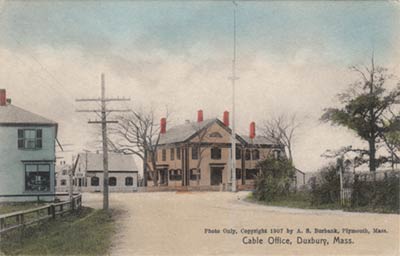
The Duxbury Cable Office on a 1907
postcard.
Detail of building |
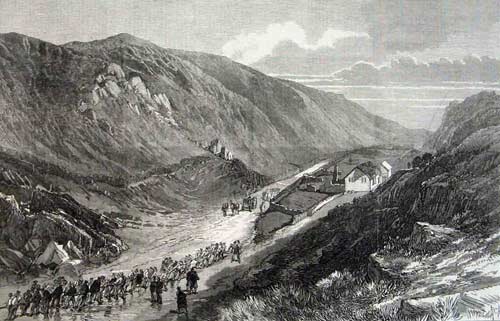
Landing of the shore end of the French
Atlantic Telegraph cable at Minou, near Brest
[From a drawing by Robert Dudley, Illustrated London News, July 3, 1869] |
|
| References:
1. Benjamin,
S. G. W: Along the South Shore, Harper’s new monthly magazine./
Volume 57, Issue 337, June 1878:
“Duxbury immediately adjoins Kingston, at the head of Plymouth Bay,
admirably situated, beyond most towns in New England, in a lovely undulating
landscape washed by a beautiful sheet of water. Like almost every town
in Massachusetts, it derives its name from a spot in old England endeared
to the first settlers by many fond memories.
“In more recent times Duxbury has been noted for ship-building, and
its name has been carried to all parts of the world by some of the finest
and fleetest vessels that ever clove the sea waves and defied the storm.
In 1869 the landing of the French cable at Duxbury gave the little town
a novel interest.
“Marshfield immediately adjoins Duxhury on the north. It is a straggling
township, divided in to Marsbfleld, Marshfield Centre, East Marshfleld,
Sea View, Webster Place, Cut River, and Brant Rock, the whole scarcely
aggregating two thousand souls. The township was first settled by Edward
Winslow the third Governor of Plymouth Colony, in 1632. The place was
first called Green Harbor, then Wrexham by the Welsh whom Winslow brought
to this country, and eventually Marshfield.”
2. Hazewell,
C.C.: The Seventh Decade of the Nineteenth Century, Harper’s new
monthly magazine. / Volume 42, Issue 248, January 1871.
3. Bright,
Charles: Submarine Telegraphs, Their History, Construction and Working,
London. 1898.
4. Haigh,
K.R.: Cableships and Submarine Cables, London, 1968, Adlard Coles.
5. Scientific
American, New Series, Volume 18, Issue 14, New York, April 4, 1868.
6. Scientific
American, New Series, Volume 21, Issue 3, New York, July 17, 1869.
7. Stephenson,
Robert Louis: Memoir of Fleeming
Jenkin, 1887.
8. Smith,
Willoughby: The Rise and Extension of Submarine Telegraphy, London,
1891, J.S. Virtue & Co. Reprinted New York, 1974, Arno Press.
9. Scientific
American, New Series, Volume 21, Issue 6, New York, Aug 7, 1869.
10. Scientific
American, New Series, Volume 21, Issue 13, New York, Sept 25, 1869
See also:
The
landing of the French Atlantic Cable at Duxbury, Mass.: July, 1869,
Boston, 1869, A. Mudge & Son, Printers.
Hoyt, Franklin
Kaye:The French Atlantic Cable 1869, Duxbury 1982. Published by
the Duxbury Rural & Historical
Society and may be ordered through the Society’s website. Hoyt’s booklet
notes that he was given two bound volumes of the corporate records of
the Atlantic Telegraph Company of 1856, and the Anglo-American Telegraph
Company of 1866, and these volumes are now in the Society’s library.
The Duxbury Historical Society has a museum in the King Caesar House in Duxbury, with a sizeable
collection of equipment that was once used in the telegraph office. The
museum is open June through August, Wed-Sun 1-4 pm, and during September,
Sat-Sun 1-4 p.m.
The Society’s Drew Archival Library has a finding aid for its French Atlantic Cable Collection. A blog post gives more information.
Mahler,
Heinrich: Das franzosisch-amerikanische Kabel, Berlin, 1871,
8vo. 42pp, folding map.
Underwater
Cables in the Brest Harbor - a short History of French Trans-Atlantic
Telegraph Cables from the French Viewpoint (in English)
Article from Chambers’ Journal, London, reproduced by Scientific American |

